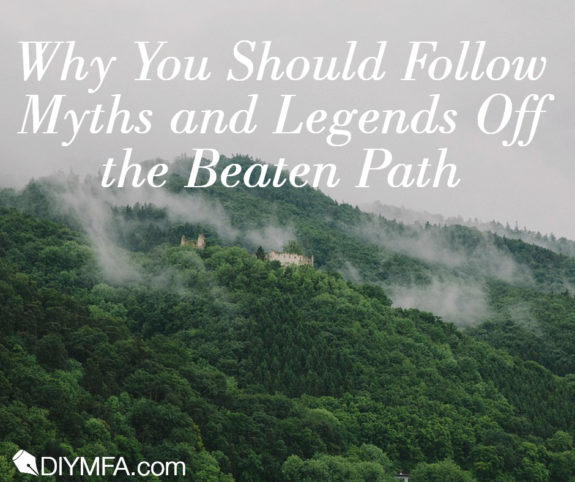Myths and legends are rich resources for writers. It’s undeniable. But before you head out to write yet another take on Arthur and the valiant knights of the round table, or Robin Hood, or the Greek, Roman, or Norse gods, it might be interesting to dig a little further into the myths and legends that interest you.
Look for the character that everyone else glosses over, or someone obscure in the pantheon who never gets the credit they deserve. There are a lot of (even more) interesting stories out there if you take the time to dig deep.
Let’s take a look at a case study: I followed Tlachtga off the beaten path of Irish myth and legend. This is where she led me
Tlachtga
The name is, like many Irish names, a challenge to pronounce. Google it, and you’ll find a recording that will help. Though the T is technically still present at the beginning of the word, the pronunciation comes out sounding like kleek-ga. You might just have to pop a glottal stop to get the T in.
Tlachtga is both a place and a person of myth. The place is also known as the Hill of Ward in county Meath. It’s about twelve miles from the better-known Hill of Tara. There are also a number of sacred wells in the area. It’s at Tlachtga where the Samhain Fire Festival is held. Samhain is the original celebration of what we know as Halloween.
That’s how I latched on to Tlachtga. Though my ancestry is Finnish on my father’s side, it’s Irish on my mother’s. I was born on Halloween at dusk. I’m a veilish baby, and I’ve been fascinated with the fire festivals since I was a child. When I came across Tlachtga in my reading some years ago, I had to know more.
The mythic Tlachtga appears in multiple tales over a number of time periods. She’s mentioned in poems within the Banshenchas, or “Lore of Women” and the Dinsenchas, or the “Lore of Places.”
In the most common story, she was the daughter of the druid Mog Roith and likely a druid herself. They travelled throughout Europe, looking for artifacts of power and ancient lore. They also studied in Italy with the sorcerer Simon Magus, whose three sons each fathered one of three triplets on Tlachtga.
Here’s where it gets classically misogynistic. Some tales call the event a sexual assault—for which none of Magus’s sons are called to account. Some gloss over the crime. Some tales say Tlachtga died giving birth to those three babies. This kind of ugliness is all over the classic myths and legends. You have to be prepared when you go digging just what you’ll unearth.
We can’t necessarily erase these events from the story, either. Tlachtga’s three sons, Doirb, Cumma, and Muach became the chieftains of Leinster, Munster, and Connaught, three of Ireland’s provinces. It was said that as long as their names were remembered, Ireland would never fall to foreign rule.
Tlachtga translates to earth spear, which some scholars associate with lightning. Mog Roith means devotee of the wheel, which may be linked with the sun. The earliest mention of Tlachtga is associated with the Firbolg, which predate the Tuatha De Dannan and the Milesians. Mog Roith is said to have served Cormac mac Art and Fionn mac Cumhail (both third century AD), and another mention, from the Lebor Gabála Érenn, goes back to the time of Conmael, nearly two thousand years before. They’re all over the historical map.
Both Tlachtga and her father made magical artifacts, too. While in Italy, Simon Magus helped them construct the Roth Rámach, or rowing wheel, which was a flying machine. I’m thinking sky chariot. Tlachtga created a pillar stone called Cnamhcaill or bone damage from a fragment of Roth Rámach. Anyone who looked at it went blind, anyone who heard it went deaf, and anyone who touched it, died.
There is one more theory that might explain their long lives (if those varied mentions are all the same people) and miraculous works. They were pagan gods, suppressed or largely written out of the records by Christian scribes. Tlachtga could have been the goddess of lightning and Mog Roith the god of the sun.
Taking it to the Page
Though the mentions of Tlachtga are few and far between, and the myths and legends about them vary in some of their details, it’s those very gaps that can fire your imagination.
For example, you could take the hateful details and do a feminist revision. Maybe the triplets were the result of consensual polyamory, or serial monogamy. Maybe Tlachtga didn’t die in childbirth and lived to bring up her children in love and light. Maybe she didn’t have triplets, but three separate births a reasonable nine to twelve months apart. Or, perhaps there was some threat to her or her children that faking her death would have protected them from.
Also, some scholars theorize that Cnamhcaill was a lightning rod or a device that attracted and stored lighting. It would explain some of its effects. Maybe Tlachtga and Mog Roith were early scientists. That would be an awesome angle to explore.
We all know that the truth is not necessarily in the recorded story, but in the spaces between. But maybe that’s just my veilish side expressing itself again.
Jesting aside, as writers, we have a responsibility to treat any source material with respect, to maintain the integrity of the spirit and intent of the original story as much as possible. The thing is that what we understand as Irish myth and legend grew out of an oral culture that survived wave after wave of foreign influence and invasion. From what myth records as the Firbolg, the Tuatha De Danann, and the Milesians, through the Romans, Angles, Saxons, and Vikings, to the Normans, the original tales endured, though no doubt altered.
By the time they were written down, by educated and likely Christian men, some of the truth of the originals may have been lost. This is not to say that we have carte blanche in re-envisioning these myths and legends but that we have to understand our own role in this checkered history to ensure we do no further harm.
Look into any cultural history deep enough, and you’ll find gems like Tlachtga waiting to be uncovered. Pursue the angles that fascinate you and you’ll be following myth and legend off the beaten path and into the pages of your own marvelous tale.
Until next time, keep speculating and see where it leads you!
Resources
- https://www.druidry.org/library/tlachtga-and-ancient-roots-halloweensamhain
- https://aliisaacstoryteller.com/2015/10/26/tlachtga-goddess-of-earth-and-fire/
- https://www.knowth.com/hill-of-ward.htm

Melanie Marttila creates worlds from whole cloth. She’s a dreamsinger, an ink alchemist, and an unabashed learning mutt. Her speculative short fiction has appeared in Bastion Science Fiction Magazine, On Spec Magazine, and Sudbury Ink. She lives and writes in Sudbury, Ontario, Canada, where she spends her days working as a corporate trainer. She blogs at https://www.melaniemarttila.ca and you can find her on Facebook and Twitter.







